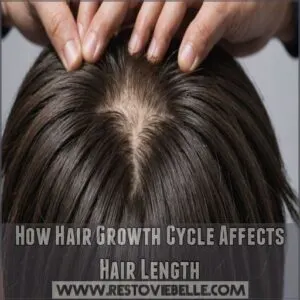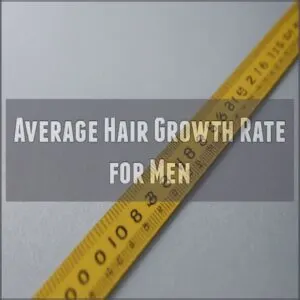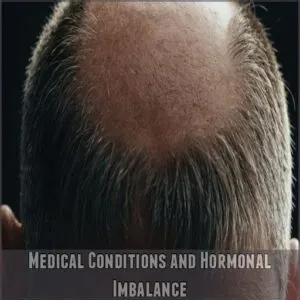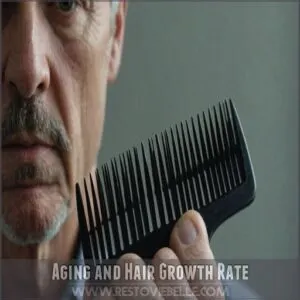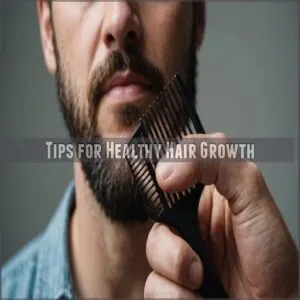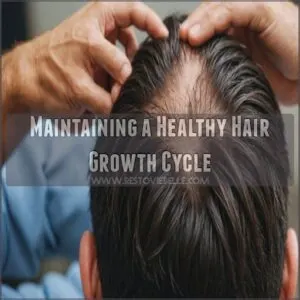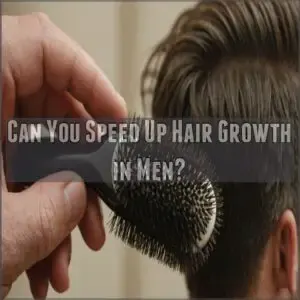This site is supported by our readers. We may earn a commission, at no cost to you, if you purchase through links.
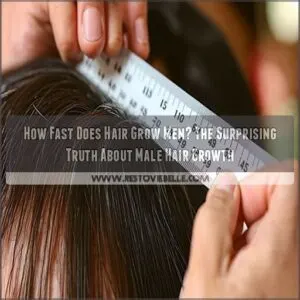 Ever wonder how fast does hair grow for men?
Ever wonder how fast does hair grow for men?
Your hair grows around half an inch per month, roughly six inches a year.
But don’t throw away your ruler just yet—factors like genetics, age, and hormones can speed up or slow down this process.
Your hair’s growth rate is a bit like your favorite plant needing the right soil and sunshine.
So, if you’re experiencing hair-raising questions about your growth rate, know that you’re not alone.
There’s more beneath the surface when it comes to nurturing those locks and keeping them healthy and strong!
Table Of Contents
- Key Takeaways
- Hair Growth Cycle Explained
- Average Hair Growth Rate for Men
- What Can Affect Hair Growth Rate?
- Tips for Healthy Hair Growth
- Maintaining a Healthy Hair Growth Cycle
- Can You Speed Up Hair Growth in Men?
- When to Seek Professional Help for Hair Loss
- Frequently Asked Questions (FAQs)
- How fast does hair grow?
- How many inches does hair grow per year?
- Does hair grow faster male or female?
- How long does hair grow per month?
- Which age group has the fastest hair growth rate?
- How much hair grows a day?
- Can hair grow 1 inch a month?
- How fast does mens hair grow in a week?
- Can you speed up hair growth men?
- How long does it take to grow 10 inches of hair?
- How does diet impact mens hair growth?
- Is hair growth different across ethnic groups?
- Does exercise improve hair growth in men?
- Can weather conditions affect hair growth rate?
- How often should men trim their hair?
- Conclusion
Key Takeaways
- Your hair grows about half an inch per month, roughly six inches a year, but factors like genetics, diet, and hormones can make this vary.
- Understanding your hair’s growth cycle can help manage expectations: anagen (growth), catagen (transition), telogen (rest), and exogen (shedding) are the phases your hair goes through.
- A balanced diet rich in protein, vitamins, and minerals is crucial for hair health and can support optimal growth.
- Managing stress, reducing heat styling, and avoiding harsh chemicals are essential practices for maintaining healthy hair growth.
Hair Growth Cycle Explained
Your hair’s growth cycle is a fascinating process that is influenced by factors such as genetics and overall health, including a balanced diet rich in protein, vitamins, and minerals to boost hair growth. Your hair’s growth cycle is a fascinating process that affects its length and appearance.
You’ll find that understanding the four phases – anagen, catagen, telogen, and exogen – can help you better manage your hair’s health and growth.
Anagen, Catagen, Telogen, and Exogen Phases
The hair growth cycle is like a four-act play, each phase with its own starring role.
Your locks go through:
- Anagen: The growth spurt (2-8 years)
- Catagen: The brief shift (2 weeks)
- Telogen: The chill-out period (2-3 months)
- Exogen: The grand finale (shedding)
Understanding these phases helps you grasp why your hair behaves the way it does.
It’s not just growing; it’s performing a complex dance on your scalp.
How Hair Growth Cycle Affects Hair Length
Your hair’s length is like a marathon runner’s distance – it’s all about how long it stays in the race.
The anagen phase, your hair’s growth stage, can last anywhere from two to eight years, during which a healthy diet rich in hair-healthy nutrition, such as protein intake for hair growth, plays a vital role.
That’s your hair’s golden ticket to length.
Once it hits the finish
Factors Influencing Hair Growth Rate
Ever wondered why some guys sport luscious locks while others battle thinning hair?
It’s all about the factors influencing hair growth rate.
Age, diet, genetics, stress, and hormones play key roles in this follicular dance.
Your hair’s growth cycle can be thrown off by nutrient deficiencies, hormonal imbalances, or even that looming work deadline.
Understanding these hair growth factors helps you take control of your mane and potentially sidestep male pattern baldness.
Average Hair Growth Rate for Men
You might be surprised to learn that the average monthly hair growth rate can vary greatly due to genetics and hormones. Men’s hair grows about half an inch per month on average.
This growth rate translates to approximately 0.35 millimeters per day, though factors like genetics, hormones, and overall health can influence how quickly your locks lengthen.
Calculating Daily and Weekly Hair Growth
Curious about your hair’s growth rate?
Let’s crunch some numbers.
On average, men’s hair grows about 0.35 millimeters per day.
That’s roughly 2.45 millimeters or 0.1 inches weekly.
You can explore products designed to support this growth at hair growth supplements.
To track your progress, use a hair growth calculator or
Factors Affecting Hair Growth Speed
Growing at an average rate of half an inch per month, hair growth is influenced by various factors.
While genetics play a role, you can impact your hair’s health through:
- Nutrition: A balanced diet rich in protein, vitamins, and minerals
- Lifestyle: Managing stress and getting adequate sleep
- Age: Hair growth typically slows as you get older
Understanding these factors helps you take control of your hair health.
Remember, what works for your buddy mightn’t work for you – everyone’s hair is unique.
Genetics and Hormonal Balance Impact
Your genes and hormones play a huge role in your hair’s growth rate.
Testosterone levels can make or break your mane, while hair loss genes might put you on the fast track to a receding hairline.
Hormonal changes can throw your hair for a loop, and conditions like androgenetic alopecia or thyroid issues can slow things down, and research has shown that excess testosterone levels
What Can Affect Hair Growth Rate?
Your hair’s growth rate isn’t set in stone; various factors can speed it up or slow it down.
From medical conditions and stress to your diet and age, understanding these influences can help you maintain a healthy mane.
Medical Conditions and Hormonal Imbalance
While the average beard growth rate is around 0.3 to 0.5 millimeters per day, or 1/3 to 1/2 inch per month as discussed in the beard growth science, average hair growth rates are helpful benchmarks, medical conditions and hormonal imbalances can throw a wrench in the works.
These factors can greatly impact your hair’s growth cycle:
- Hormonal Hair Loss: Androgenetic Alopecia (Male Pattern Baldness)
- Thyroid Issues: Hyper or hypothyroidism
- Autoimmune Disorders: Alopecia Areata
- Nutritional Deficiencies: Iron or vitamin D shortages
Understanding these potential roadblocks puts you in the driver’s seat of your hair health journey. It’s like solving a puzzle – once you identify the pieces, you’re halfway to finding solutions.
Stress and Illness Effects on Hair Growth
Ever feel like stress is making your hair fall out?
It’s not just in your head.
Stress and illness can throw your hair growth cycle off balance, leading to temporary hair loss called telogen effluvium.
Don’t panic, though – it’s usually reversible.
| Condition | Effect on Hair |
|---|---|
| Acute Stress | Pushes hair into resting phase |
| Chronic Illness | Disrupts nutrient absorption |
| Recovery | Hair typically regrows within months |
Understanding these impacts empowers you to take control of your hair health, even when life gets hairy.
Aging and Hair Growth Rate
Father Time’s clock ticks for your locks.
As you age, hair growth slows down, and follicles shrink.
This leads to thinner, shorter strands and potential hair loss.
Graying hair and texture changes are also common.
Additionally, adopting healthy habits such as a balanced Diet Rich in Antioxidants, maintaining scalp health, and addressing hormonal changes can help manage these effects on your hair.
Diet and Nutrition Impact on Hair Growth
You are what you eat, and your hair is no exception.
A nutrient-rich diet plays a key role in hair growth and density.
Essential nutrients like biotin, iron, and zinc nourish your hair follicles, promoting faster growth and thicker strands.
Hair-friendly foods include eggs, salmon, and spinach.
Nutritional deficiencies can slow hair growth, so focus on a balanced diet for the best results.
Remember, feeding your body well means feeding your hair well too.
Tips for Healthy Hair Growth
You’ll be surprised how simple changes can boost your hair’s health and growth.
From tweaking your diet to mastering gentle styling techniques, these evidence-based tips will help you nurture your mane and potentially speed up its growth rate.
Balancing Diet for Hair Health
Genetics and hormonal imbalances, such as those caused by thyroid problems and stress, also impact hair growth, but your diet plays a starring role in follicle health.
Fueling your body with the right nutrients can make a world of difference.
Here’s a menu for luscious locks:
- Protein-packed foods: Eggs, lean meats, and fish build strong strands
- Iron-rich options: Spinach and lentils boost oxygen flow to follicles
- Biotin bonanza: Nuts and seeds promote thickness and shine
Remember, what’s on your plate today shapes your mane tomorrow.
Reducing Stress and Improving Sleep
Eating right isn’t the only way to boost your mane.
Stress and poor sleep can put the brakes on hair growth.
Let’s explore some stress-busting techniques and sleep hacks that’ll have your follicles singing.
Check out this handy guide to help you chill out and catch those Z’s:
| Stress Management | Sleep Hygiene | Hair Growth Impact |
|---|---|---|
| Deep breathing | Consistent schedule | Reduces cortisol |
| Meditation | Dark, cool room | Promotes anagen phase |
| Exercise | Limit screens | Improves nutrient delivery |
| Journaling | Relaxing bedtime routine | Decreases telogen effluvium |
| Social connection | Comfortable bedding | Enhances overall hair health |
Gentle Hair Care and Styling Techniques
Gentle care is the secret sauce for healthy hair growth.
Treat your locks like a prized possession, and they’ll reward you with strength and shine.
Using a hair growth shampoo can also be a great addition to your hair care routine.
Here’s your game plan:
- Give your scalp a daily massage to boost blood flow
- Use a wide-to
Avoiding Damage From Heat Styling and Chemical Treatments
Heat styling and chemical treatments can be hair’s worst enemies.
To keep your mane in top shape, dial down the temperature on your styling tools and limit their use.
Opt for heat protectants and natural drying methods when possible.
Here’s a quick guide to help you navigate the dos and don’ts:
| Treatment | Risk Level | Prevention Tips |
|---|---|---|
| Flat Iron | High | Use heat protectant, keep temp below 350°F |
| Hair Dye | Medium | Space out colorings, use sulfate-free shampoo |
| Blow Drying | Medium | Use cool setting, keep 6 inches away |
| Perms | High | Wait 2-3 months between treatments |
| Bleaching | Very High | Seek professional help, deep condition regularly |
Remember, treating your hair like a prized possession pays off in the long run.
Your future self (and your luscious locks) will thank you!
Maintaining a Healthy Hair Growth Cycle
You’ve got the power to keep your hair growth cycle in top shape.
By managing stress, maintaining a clean scalp, and avoiding harsh treatments, you’ll give your locks the best chance to grow strong and healthy.
Managing Telogen Effluvium and Hair Loss
Frequently, stress throws your hair growth cycle for a loop, triggering telogen effluvium.
To regain control, tackle stress head-on with meditation or exercise.
Boost your diet with hair-friendly nutrients like biotin and iron.
Consider supplements, but chat with your doc first.
Gentle scalp massages can wake up sleepy follicles.
Remember, patience is key – your hair’s just taking a breather, not saying goodbye forever.
Regular Trims for Preventing Breakage
Trimming your hair regularly isn’t just about style—it’s a game-changer for hair health.
You’ll prevent split ends from traveling up the hair shaft, which can stunt growth.
Here’s why regular trims are your hair’s best friend:
- Removes damaged ends, promoting healthier growth
- Maintains hair shape, reducing tangles and breakage
- Stimulates hair follicles, potentially boosting growth rate
- Allows for even distribution of natural oils
- Helps you track hair length progress accurately
Keeping The Scalp Clean and Healthy
Your scalp is the root of healthy hair growth.
Keep it clean with a gentle shampoo, washing every 2-3 days to balance oil production.
Massage your scalp during washing to boost blood flow and stimulate hair follicles.
This can help prevent dandruff and promote hair density.
Remember, a healthy scalp equals happy hair.
It’s like tending a garden – nurture the soil, and your hair will flourish.
Avoiding Harsh Chemicals and Heat Styling
A squeaky-clean scalp lays the groundwork, but avoiding harsh chemicals and heat styling truly guards against hair damage.
Try opting for a chemical free shampoo alternative to reduce damage.
Embrace natural hair care and lean towards chemical-free products.
Swap out your flat iron for heat styling alternatives like air-drying.
Remember, healthy hair habits go a long way in preventing hair thinning.
Can You Speed Up Hair Growth in Men?
You might wonder if there’s a magic trick to speed up your hair growth, but it’s not that simple.
While you can’t control your hair’s pace like planning a road trip, several treatments and lifestyle changes can help optimize growth conditions.
Effective Supplements for Hair Growth
As you maintain a healthy hair growth cycle, explore effective supplements to boost hair growth.
Biotin benefits hair density and is often included in hair vitamins.
Compare supplements to find the best fit.
Natural options, like DIY hair masks, can also nourish your scalp.
Remember, what works wonders for some mightn’t suit others, so tailor choices wisely.
Minoxidil and Other Medications for Hair Growth
Supplements aside, tackling hair loss with medications like Minoxidil can bring promising results. You’re probably wondering, "Will it happen overnight?" Not quite. Here’s what to expect:
- Minoxidil: Boosts hair growth, but watch out for side effects.
- Finasteride: Often compared to Minoxidil.
- Rogaine alternatives: Explore options.
- Medication effectiveness: Varies by individual.
- Male pattern baldness: Not the end game!
Low-Level Laser Therapy (LLLT) for Hair Growth
Ever wondered if men’s hair regrowth treatment, such as Hims Hair Regrowth Treatment, can help men regrow their hair in 3 to 6 months. Ever wondered if low-level laser therapy (LLLT) can boost hair growth in men?
It’s like a gentle nudge for your hair follicles, enhancing growth without much fuss.
LLLT devices offer a safe route, though side effects are rare.
Cost varies, effectiveness differs, so weigh options carefully.
| Aspect | Detail | Note |
|---|---|---|
| Effectiveness | Varies among users | Individual results |
| Safety | Generally safe | Few side effects |
| Cost | Moderate to expensive | Varies by device |
Platelet-Rich Plasma (PRP) Therapy for Hair Growth
Switching from laser therapy’s futuristic beams, let’s explore Platelet-Rich Plasma (PRP) therapy.
This treatment uses your blood to potentially awaken sleepy hair follicles, boosting hair growth.
While the PRP therapy benefits are promising, keep in mind its costs and side effects.
Comparing PRP vs. hair transplant, PRP offers a less invasive option, though results can differ.
When to Seek Professional Help for Hair Loss
Noticeable hair thinning, a receding hairline, or sudden excessive shedding?
Don’t panic, but it’s time to consult a healthcare professional for an accurate diagnosis and personalized treatment plan to address your hair loss concerns.
Identifying Signs of Hair Loss
With the hope of speeding up hair growth, pinpointing signs of hair loss becomes essential.
Spot a receding hairline or thinning crown?
How about a widening part or bald patches making you uneasy?
Notice excessive shedding or hair follicles looking sparse?
Understand these can all signal male pattern baldness.
Recognize these signs early to regain control over your mane.
Consulting a Healthcare Provider for Hair Loss
Spotting thinning hair might make you wonder, "Why me?"
When hair loss becomes noticeable or distressing, chatting with a healthcare provider can be eye-opening.
They’ll assess your medical history, lifestyle factors, and hair loss causes to offer a personalized diagnosis.
It’s not just about hair loss; it’s about finding the right path to healthier hair growth.
Treatment Options for Hair Loss in Men
Hair loss got you pulling your hair out?
There’s a raft of treatments available—like hair transplant surgery, natural remedies, and medication options such as Minoxidil.
Lifestyle changes, PRP therapy, and personalized treatments can also help tackle male pattern baldness.
If your hair loss is affecting your confidence or daily life, don’t hesitate to connect with a healthcare provider.
Frequently Asked Questions (FAQs)
How fast does hair grow?
Your hair typically inches along at about half an inch per month, or 35 millimeters a day.
Factors like genetics, nutrition, and stress levels can affect this pace.
So keep your scalp healthy for better growth.
How many inches does hair grow per year?
On average, hair grows about half an inch monthly. That means you can expect around six inches of growth yearly. However, individual growth rates vary.
Does hair grow faster male or female?
Men’s and women’s hair generally grows at a similar rate—about half an inch per month.
However, factors like genetics, hormones, and health can influence growth speed differently in individuals, adding some spice to the mix!
How long does hair grow per month?
Regarding hair growth, patience is key.
Hair typically grows about half an inch (25 centimeters) each month.
Embrace a healthy lifestyle to support this natural process, and you’ll see steady progress over time.
Which age group has the fastest hair growth rate?
Kids and teenagers typically experience the fastest hair growth, with their growth phases being longer than adults.
This results in quicker and healthier hair growth, thanks to more active hair follicles still thriving during youth.
How much hair grows a day?
Did you know hair grows about 35 millimeters a day?
That’s like a tiny construction site on your head, quietly expanding.
Regular exercise, such as cardiovascular exercises for hair growth, can also promote healthy growth in those active follicles. Keep a balanced diet and manage stress to promote healthy growth in those active follicles.
Can hair grow 1 inch a month?
Hair generally grows about half an inch per month, so achieving an inch might feel like pushing the pedal to the metal.
However, genetics, diet, and health can speed or slow this sprint to Rapunzel-like lengths.
How fast does mens hair grow in a week?
Imagine hair growing like grass on steroids, but reality checks in.
Men’s hair typically grows about 35 millimeters a day, so you’re looking at roughly 5 millimeters of growth each week, unless something’s amiss.
Can you speed up hair growth men?
You can’t magically speed it up, but you can optimize growth. Eat well, manage stress, and be gentle with your scalp and hair. A healthy lifestyle is key!
How long does it take to grow 10 inches of hair?
Growing 10 inches of hair typically takes between 20 and 24 months, given hair grows about half an inch monthly.
Individual differences, including genetics and lifestyle, can influence this timeline, adding a dash of unpredictability.
How does diet impact mens hair growth?
Protein fuels hair strength, vitamins support scalp health, and iron encourages follicle function.
Eating a balanced diet rich in zinc, biotin, and omega-3 fatty acids promotes thicker, shinier hair, while nutrient deficiencies may cause brittle strands.
Is hair growth different across ethnic groups?
Hair growth varies across ethnic groups due to genetic factors.
Typically, Asian hair grows fastest.
While Caucasian hair has the most density.
Afro-textured hair grows at a slower rate but has unique curl patterns.
Does exercise improve hair growth in men?
Imagine running a marathon not just for your health, but your hair too.
Exercise boosts blood circulation, delivering oxygen and nutrients to hair follicles, which may improve hair thickness and growth rate over time for men.
Can weather conditions affect hair growth rate?
Cold weather can slow down your hair growth due to reduced blood circulation to the scalp.
Warm climates encourage growth by improving circulation.
However, humidity can lead to frizz without affecting hair growth rate to a great degree.
How often should men trim their hair?
Trim your hair every 4 to 6 weeks to maintain shape and style, especially if you prefer shorter haircuts.
Regular trims help prevent split ends, keeping your hair healthy and manageable while enhancing your overall appearance.
Conclusion
Ultimately, understanding how fast does hair grow men is key to managing expectations.
Your hair growth, while seemingly slow at a half-inch monthly, is a marathon, not a sprint!
Genetics, diet, and stress all play a significant role.
Remember, consistent healthy habits—a balanced diet, stress management, and gentle hair care—can help optimize your hair growth potential.
Don’t expect miracles overnight, but with patience and the right approach, you can nurture healthier, stronger hair.
Knowing the average growth rate for men helps you set realistic goals for hair length.

